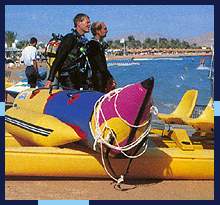Red
Sea Coast
SEAGRASS
MEADOWS
Snorkelling
or diving in seagrass or sandy areas may seem at first sight
to be less rewarding, however there can be a lot to see in
these areas too.
 |
Seagrasses
are not related to seaweeds, which are algae not plants; they
are the only group of "higher" (flowering) plants that can
live completely submerged throughout their life. Seagrass
ecosystems are most active at night but during the day you
are likely to see rays and a lot of echinoderms: starfish,
sea urchins and sea cucumbers. Sea cucumbers look like giant
slugs but they are actually closely related to starfish and
urchins, and a cross section through them would show the five-sided
pentagon shape that is a feature of the echinoderms. Sea cucumbers
have a unique defence mechanism: when harassed by predators
they can spill out all their intestines through their mouth.
The predator can eat the intestines and the animal remains
alive and can subsequently regrow its guts. (Please don't
try to make the animal do this! It is a last resort defence
mechanism and they often die of starvation before the digestive
system has grown back.) Sea cucumbers also form a rather unique
habitat for another animal: a species of fish which takes
refuge from predators by living inside the anus…
MANGROVES
Another
important ecosystem which is part of this coastal habitat
"mosaic" is mangroves. Mangroves are trees of several species
which have adapted to life with their root systems submerged
in seawater, something which normally causes plants problems
with salt regulation and oxygen supply to the roots. Mangroves
either have roots systems raised out of the ground like stilts,
or upwards growths from
|

|
the
roots that poke out of the ground - both of these are adaptations
to ensure that the roots get enough oxygen. Some species (e.g.
the white mangrove Avicennia marina - the most common in Egypt)
have salt glands to get rid of excess salt; if you turn the
leaves over you will find them coated with salt crystals.
Mangroves
tend to occur in patches down the coast in Egypt; you may
notice them particularly where a wadi (floodwater valley)
enters the sea from the mountains. Although wadis appear dry
except during occasional rain storms, they usually support
a year-round trickle of groundwater. This supply of freshwater
makes life easier for the mangroves. Mangroves have been used
throughout the Red Sea for thousands of years, since they
are one of the few sources of timber in this arid region.
Traditional fishing boats are often made partly of mangrove
wood, and buildings in the ancient cities of Arabia have beams
made of mangrove wood.
Mangroves
are key components of the coastal ecosystem "mosaic" because
of their importance as a nursery ground for baby fish and
shrimp. Fish and shrimp larvae have many predators, and require
lots of shelter to survive to have a chance of surviving to
a size where they can migrate into the seagrass and patch
reef area and eventually out on to the reef. Mangrove roots
provide a refuge from predators for the larvae and small juveniles
of many reef species.
OTHER
SPECIES
Four
species of turtle nest along Egypt's coast: green, loggerhead,
hawksbill and leatherback; turtles, particularly greens and
hawksbills, are frequently seen by divers foraging on reefs.
Hawksbills eat sponges, jellyfish and other invertebrates,
greens algae and seagrass. Leatherbacks eat jellyfish and
are less commonly seen on reefs. The Red Sea is an important
route for migratory birds, particularly during spring and
autumn: you may see songbirds and swallows from Europe; stocks,
cranes and other waders; and birds of prey.
(Jo
Gascoigne)
|
|